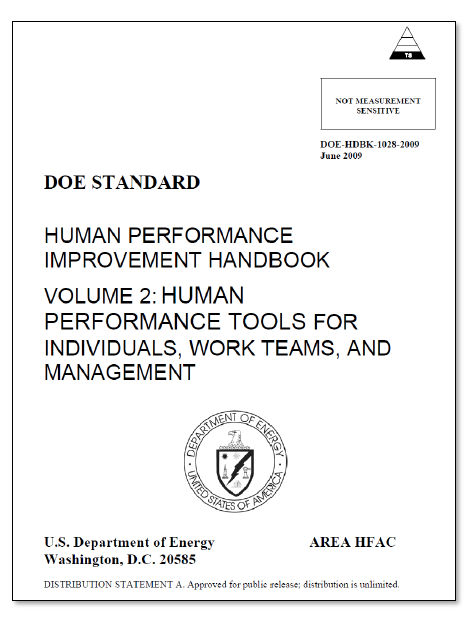Administrative Controls

taken from DOE-HDBK-1028-2009
A safety minute from whatisnuclear.com contributed by Michael Riddle
Human Performance Error Rate Summarization
-
About 80% of all events are attributed to human error.
- In some industries, this number is closer to 90%.
-
When the 80% human error is broken down further, it reveals:
- 70% stem from latent organizational weaknesses (perpetrated by humans in the past that lie dormant in the system)
- 30 percent are caused by the individual worker touching the equipment and systems in the facility.
Nuclear Industry Human Performance Error Rates
- An analysis of significant events in the commercial nuclear power industry between 1995 and 1999 indicated that three of every four events were attributed to human error, as reported by INPO.
-
Additionally, a Nuclear Regulatory Commission review of events in which fuel was damaged while in the reactor showed that human error was a common factor in 21 of 26 (81 percent) events.
- The report disclosed that “the risk is in the people the way they are trained, their level of professionalism and performance, and the way they are managed.”
Nuclear Industry Human Performance Error Rates (Continued)
- Engineers and other knowledge based workers contribute differently than first line workers to facility events.
- A recent study completed for the Nuclear Regulatory Commission (NRC) by the Idaho National Engineering and Environmental Laboratory (INEEL) indicates that human error continues to be a causal factor in 79 percent of industry licensee events.
- Within those events, there were four latent failures (undetected conditions that did not achieve the desired end(s)) for every active failure. More significantly, design and design change problems were a factor in 81 percent of the events involving human error.
Engineering Overconfidence
- Recognizing that engineers and other knowledge based workers make different errors, INPO developed a set of tools specific to their needs.
- With engineers, specifically, the errors made can become significant if not caught early.
- As noted in research conducted at one DOE site, because engineers as a group are highly educated, narrowly focused, and have personalities that tend to be introverted and task oriented, they tend to be critical of others, but not self critical.
Engineering Overconfidence (Continued)
- If they are not self critical, their errors may go undetected for long periods of time, sometimes years.
- This means that it is unlikely that the engineer who made the mistake would ever know that one had been made, and the opportunity for learning is diminished.
- Thus, human performance techniques aimed at this group of workers need to be more focused on the errors they make while in the knowledge based performance mode.
Error Modes in Decision Making
-
Three major Error Modes:
- Skill Based
- Rule Based
- Knowledge Based
-
To improve human performance and facility performance, efforts should be made to:
- reduce the occurrence of errors at all levels of the organization and
- enhance the integrity of controls, or safeguards discovered to be weak or missing.
-
Reducing errors (Re) and managing controls (Mc) will lead to zero significant events (ØE). The formula for achieving this goal is: Re + Mc → ØE.
Administrative Controls - Procedures and Processes
- Policies, procedures, training, work practice processes, administrative controls and expectations direct people’s activities so that they are predictable, safe, and limit their exposure to hazards, especially for work performed in and on the facility.
- All together such controls help people anticipate and prepare for problems.
- Written instructions specify what, when, where, and how work is to be done and what personal protective equipment workers are to use.
- The rigor with which people follow and perform work activities according to correctly written procedures, expectations, and standards directly affects the integrity of this line of protection.
Administrative Controls - Common Flaws
|
|
References
CC-BY-NC whatisnuclear.com